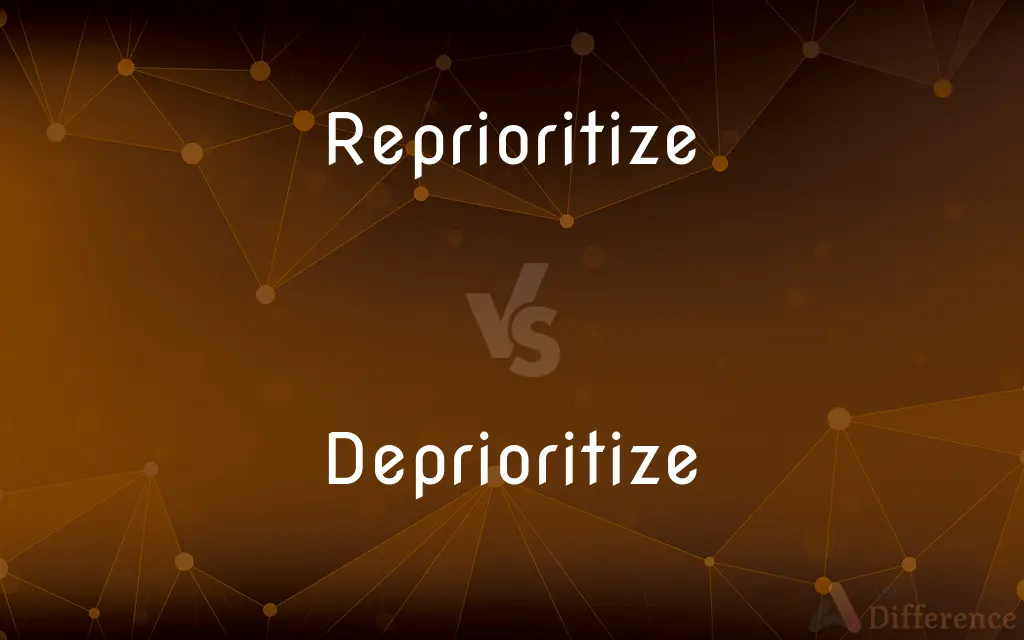Reprioritize vs. Deprioritize — What's the Difference?
By Tayyaba Rehman & Urooj Arif — Updated on April 30, 2024
Reprioritizing involves adjusting priorities to emphasize different tasks or goals, whereas deprioritizing specifically means lowering the priority of certain tasks in favor of others.

Difference Between Reprioritize and Deprioritize
Table of Contents
ADVERTISEMENT
Key Differences
Reprioritizing is a strategic process where the importance of tasks or projects is reordered based on new information or objectives, typically to enhance efficiency or respond to emerging challenges. Whereas deprioritizing involves deliberately reducing the emphasis on certain tasks, usually because they are less critical or urgent compared to others.
In a business context, reprioritizing might occur when a company shifts focus to a more lucrative market due to a change in industry dynamics. On the other hand, deprioritizing might be applied to initiatives that no longer align with the company’s revised strategic goals.
In personal time management, reprioritizing can mean adjusting one’s daily schedule to accommodate an unexpected event or opportunity, ensuring optimal use of time. Whereas, deprioritizing involves moving less urgent activities, like hobbies, to make room for more pressing commitments such as work deadlines.
Within project management, reprioritizing may involve reshuffling resources and deadlines to address the most immediate and impactful project needs first. Deprioritizing, however, typically sees less critical tasks postponed or resources reallocated away from them.
When developing software, reprioritizing might result in agile teams quickly adapting to user feedback by altering the development roadmap to prioritize new features. Deprioritizing, in this scenario, would mean delaying or reducing resources dedicated to less valuable features.
ADVERTISEMENT
Comparison Chart
Definition
Adjusting the order of priorities to meet new goals
Lowering the status of tasks in the priority list
Focus
Addressing emerging or more urgent needs first
Reducing focus on less urgent needs
Outcome
Optimizes resource allocation for current priorities
Focuses resources away from lesser goals
Typical Context
Change in strategy, unforeseen opportunities
Resource constraints, strategic realignment
Implication for productivity
Potentially increases productivity by focusing on more impactful tasks
Helps avoid spreading resources too thin
Compare with Definitions
Reprioritize
To arrange priorities to better suit current objectives.
She had to reprioritize her day to accommodate an unexpected meeting.
Deprioritize
To lower the priority level of a task or project.
Due to budget cuts, several projects were deprioritized.
Reprioritize
To shift focus in response to changing conditions.
After the market analysis, the company reprioritized its product development.
Deprioritize
To reduce the focus or resources allocated to a task.
The software update was deprioritized in favor of critical bug fixes.
Reprioritize
To change the order of importance among tasks.
The manager decided to reprioritize the project's phases to meet the new deadline.
Deprioritize
To postpone tasks that are less urgent or important.
They deprioritized the marketing campaign in light of recent sales figures.
Reprioritize
To alter resource distribution based on new priorities.
The team reprioritized their workload following the client's feedback.
Deprioritize
To reallocate resources away from lower-priority tasks.
Management decided to deprioritize the renovation project.
Reprioritize
To reorganize tasks to enhance efficiency.
He reprioritized his tasks to focus more on urgent issues.
Deprioritize
To assign lesser importance to certain tasks.
She had to deprioritize her research to meet the immediate needs of her team.
Reprioritize
(transitive) To arrange things in a new order of importance; to prioritize again.
Deprioritize
(transitive) To reduce the level of priority of.
Do you want me to deprioritize my current report to get this done?
Common Curiosities
What are the risks of reprioritizing too frequently?
Frequent reprioritization can lead to confusion, reduced morale, and a lack of progress due to constantly shifting focuses.
Is deprioritizing the same as abandoning a project?
No, deprioritizing involves lowering the importance but does not necessarily mean abandoning the project altogether.
What does it mean to reprioritize a project?
Reprioritizing a project involves adjusting the project's tasks and resources to focus on new or more pressing objectives.
Can deprioritizing help in crisis management?
Yes, deprioritizing less critical tasks can free up resources and attention for managing a crisis more effectively.
What tools can help with effective reprioritization?
Project management software and prioritization matrices are useful tools for managing task priorities effectively.
How does reprioritizing affect team morale?
If managed well, it can boost morale by aligning tasks with current goals; poorly managed, it can lead to frustration and disengagement.
What is a common trigger for deprioritizing tasks?
Common triggers include budget cuts, resource shortages, or a shift in strategic direction.
How often should teams reprioritize their goals?
Teams should reprioritize goals whenever there's a significant change in business conditions, market demands, or internal resources.
How should a manager communicate deprioritization to their team?
Clearly and with justification, explaining why it's necessary and how it fits into the broader objectives.
How does deprioritization affect project timelines?
It can extend timelines for certain tasks while possibly speeding up critical components that receive more focus.
How do personal priorities differ from business priorities when reprioritizing?
Personal priorities often align with individual goals and life balance, while business priorities align with company goals and market demands.
Why might a business choose to deprioritize a product?
Possible reasons include low sales, shift in market trends, or a strategic pivot to more profitable products.
What is the impact of not deprioritizing when necessary?
It can lead to resource inefficiency, missed opportunities, and inability to adapt to changing circumstances.
Can reprioritization lead to better customer satisfaction?
Yes, if it's done to realign the project to better meet customer needs and expectations.
What's the difference between reprioritizing and restructuring?
Reprioritizing adjusts priorities within the existing framework, whereas restructuring might involve changing the framework itself.
Share Your Discovery

Previous Comparison
Uke vs. Seme
Next Comparison
Brought vs. BoughtAuthor Spotlight
Written by
Tayyaba RehmanTayyaba Rehman is a distinguished writer, currently serving as a primary contributor to askdifference.com. As a researcher in semantics and etymology, Tayyaba's passion for the complexity of languages and their distinctions has found a perfect home on the platform. Tayyaba delves into the intricacies of language, distinguishing between commonly confused words and phrases, thereby providing clarity for readers worldwide.
Co-written by
Urooj ArifUrooj is a skilled content writer at Ask Difference, known for her exceptional ability to simplify complex topics into engaging and informative content. With a passion for research and a flair for clear, concise writing, she consistently delivers articles that resonate with our diverse audience.
















































